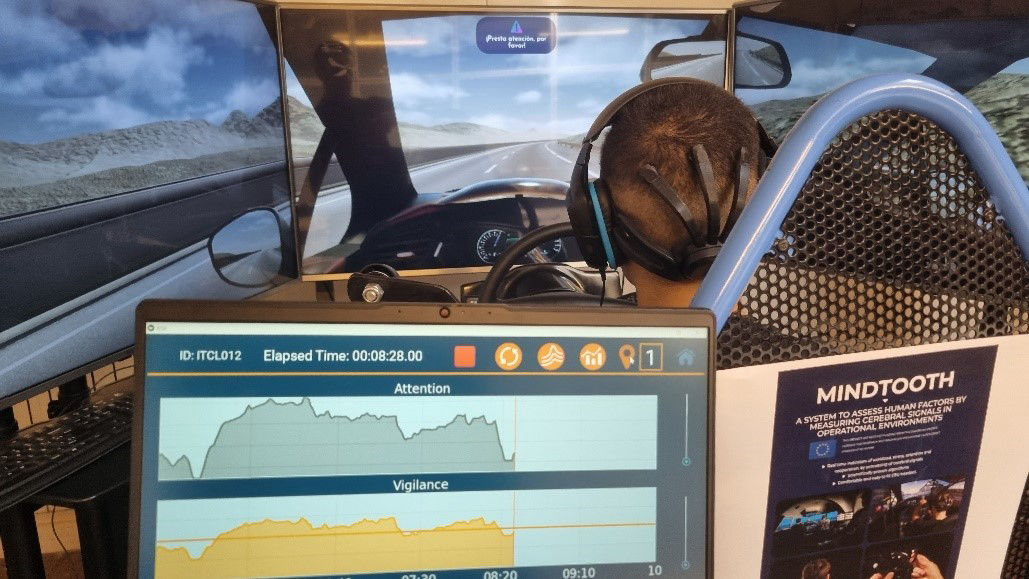
Figure 2.1
Configuration screen for the Mindtooth connection. Some options are ambiguous on purpose so that setting them in front of the volunteers did not influence them.
Mindtooth Validations
The automotive IRIS simulator, available within ITCL Technology Centre facilities has been integrated with the Mindtooth system. In particular, the ITCL IRIS Automotive Simulator is now able to send and receive information from the Mindtooth system and this information can then be used by the simulator to influence the actual simulation itself. The computer hosting the Mindtooth application opens a websocket that the simulator can connect to so that both applications feed information to each other.

Configuration screen for the Mindtooth connection. Some options are ambiguous on purpose so that setting them in front of the volunteers did not influence them.
In this case, the Mindtooth System has been used to provide the neurometric indices of Workload and Vigilance. One of the possible applications of this integration is showing messages to the driver whenever their vigilance decreases. Other applications include adjusting traffic density according to the driver’s stress level or recommending different exercises based on the driver’s mental workload. All the data collected by the Mindtooth system is automatically added to the exercise reports generated by the simulator, so it can be accessed from a single place by end users.

Popup asking the user to pay attention. This popup would show up when the vigilance threshold was reached
The experimental protocol tested two possible applications, relevant in the automotive field:
- In the current scenario, driving school trainees must attend a certain number of driving lessons to achieve the proper level of knowledge, dexterity and experience. The number of sessions in general depends on national regulations, with a certain degree of variability across Europe. At a national level, the programmes are almost standardized, and they are based on the repetition of particular driving tasks until the instructor is satisfied with the trainee’s driving performance. Therefore, trainees’ assessment mainly relies on the instructor’s subjective evaluation.. Having a tool capable of providing an objective measure of the driving trainee’s mental workload while driving would become a powerful solution for the instructor to get a complete overview of the actual trainee’s readiness to drive.
o Participants (without a driving licence) have been asked to perform 5 repeated sessions, hypothesising a decreasing in the experienced mental workload over time.
- The second application is related to the driver’s monitoring to prevent sudden mental impairments, such as distraction and loss of vigilance. It has been demonstrated that human error is the main cause of 57% of road accidents and is a contributing factor in over 75% of them. One of the most highly contributing factors is distraction, loss of situational awareness and vigilance. Current Automated Driving Assisting Systems (ADAS) equipping the vehicles and aimed to monitor driver’s vigilance are usually based on the analysis of driving behaviour and/or ocular activity. However, brain activity measures would be more effective and provided in real time. Therefore, an online tool capable of assessing the driver’s level of vigilance based on their brain activity and of recognizing any abnormal decrease would become a powerful solution to develop innovative and effective ADAS, increasing the level of safety.
o Participants have been asked to drive a monotonous circuit for 10 minutes. During the last minute, an unexpected event was introduced to disrupt the monotony of the task.

Experimental room at the University of Burgos with the two ITCL car simulators
The following graphs show the reliability of the neurometric indices of workload and vigilance, calculated by the Mindtooth system.

On the left the workload measure across training sessions, showing the decreasing over time of the workload of drivers, meaning an improvement in the training. On the right, a decreasing in the Vigilance index over time (across 8 minutes), with an increasing during the last minute due to an event, disrupting the task monotonicity.
This validation illustrates the added value of the Mindtooth system:
- in a trainee evaluation context: being able to measure when a given task is more automatic and therefore less demanding for the user, allows us to deduce that users will then be more capable of handling additional tasks and reacting to unexpected events
- to assess, in real time, the actual vigilance level of the driver in order to be intervene and mitigate the risk of accidents.
This validation was performed in 3 different contexts:
Pilot Training | Automotive Simulator | Industrial Workers